

Compact Muon Solenoid
LHC, CERN
| CMS-TOP-22-003 ; CERN-EP-2024-027 | ||
| Search for baryon number violation in top quark production and decay using proton-proton collisions at $ \sqrt{s} = $ 13 TeV | ||
| CMS Collaboration | ||
| 29 January 2024 | ||
| Phys. Rev. Lett. 132 (2024) 241802 | ||
| Abstract: A search is presented for baryon number violating interactions in top quark production and decay. The analysis uses data from proton-proton collisions at a center-of-mass energy of 13 TeV, collected with the CMS detector at the LHC with an integrated luminosity of 138 fb$ ^{-1} $. Candidate events are selected by requiring two oppositely-charged leptons (electrons or muons) and exactly one jet identified as originating from a bottom quark. Multivariate discriminants are used to separate the signal from the background. No significant deviation from the standard model prediction is observed. Upper limits are placed on the strength of baryon number violating couplings. For the first time the production of single top quarks via baryon number violating interactions is studied. This allows the search to set the most stringent constraints to date on the branching fraction of the top quark decay to a lepton, an up-type quark (u or c), and a down-type quark (d, s, or b). The results improve the previous bounds by three to six orders of magnitude based on the fermion flavor combination of the baryon number violating interactions. | ||
| Links: e-print arXiv:2402.18461 [hep-ex] (PDF) ; CDS record ; inSPIRE record ; HepData record ; CADI line (restricted) ; | ||
| Figures | |

png pdf |
Figure 1:
Representative Feynman diagrams for single top quark production (left) and top quark decays (right) via BNV interactions. The red circles mark the BNV vertices. |

png pdf |
Figure 2:
The BDT output distributions for data (points) and backgrounds (histograms) for the $ \mathrm{e}^+\mathrm{e}^- $ (left), $ \mu^{+}\mu^{-} $ (right), and $ \mathrm{e}^\pm\mu^\mp $ (lower) channels, including the ratio of data to the predicted total background yield. The hatched bands indicate the total uncertainty (statistical and systematic added in quadrature) for the SM background predictions. The predicted yields of the backgrounds and the uncertainty bands are shown after the simultaneous fits for the signal-plus-background hypothesis. Examples of the predicted signal contribution for the BNV interactions via $ \mathrm{t}\mathrm{e}\mathrm{u}\mathrm{d} $ (solid gray line) and $ \mathrm{t}\mu\mathrm{u}\mathrm{d} $ (dashed black line) vertices are shown. |
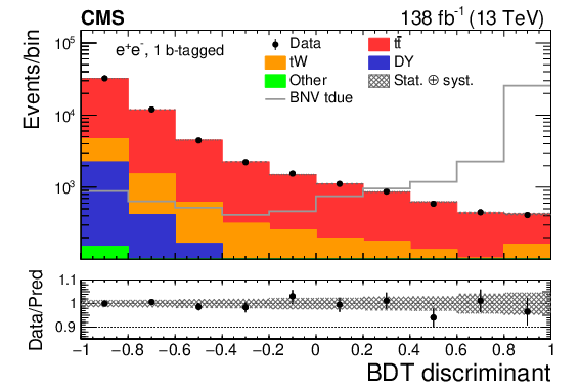
png pdf |
Figure 2-a:
The BDT output distributions for data (points) and backgrounds (histograms) for the $ \mathrm{e}^+\mathrm{e}^- $ (left), $ \mu^{+}\mu^{-} $ (right), and $ \mathrm{e}^\pm\mu^\mp $ (lower) channels, including the ratio of data to the predicted total background yield. The hatched bands indicate the total uncertainty (statistical and systematic added in quadrature) for the SM background predictions. The predicted yields of the backgrounds and the uncertainty bands are shown after the simultaneous fits for the signal-plus-background hypothesis. Examples of the predicted signal contribution for the BNV interactions via $ \mathrm{t}\mathrm{e}\mathrm{u}\mathrm{d} $ (solid gray line) and $ \mathrm{t}\mu\mathrm{u}\mathrm{d} $ (dashed black line) vertices are shown. |
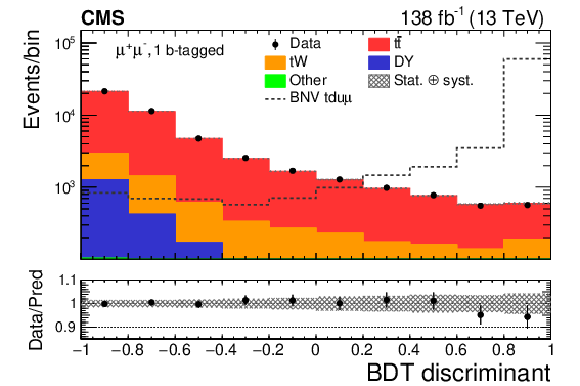
png pdf |
Figure 2-b:
The BDT output distributions for data (points) and backgrounds (histograms) for the $ \mathrm{e}^+\mathrm{e}^- $ (left), $ \mu^{+}\mu^{-} $ (right), and $ \mathrm{e}^\pm\mu^\mp $ (lower) channels, including the ratio of data to the predicted total background yield. The hatched bands indicate the total uncertainty (statistical and systematic added in quadrature) for the SM background predictions. The predicted yields of the backgrounds and the uncertainty bands are shown after the simultaneous fits for the signal-plus-background hypothesis. Examples of the predicted signal contribution for the BNV interactions via $ \mathrm{t}\mathrm{e}\mathrm{u}\mathrm{d} $ (solid gray line) and $ \mathrm{t}\mu\mathrm{u}\mathrm{d} $ (dashed black line) vertices are shown. |
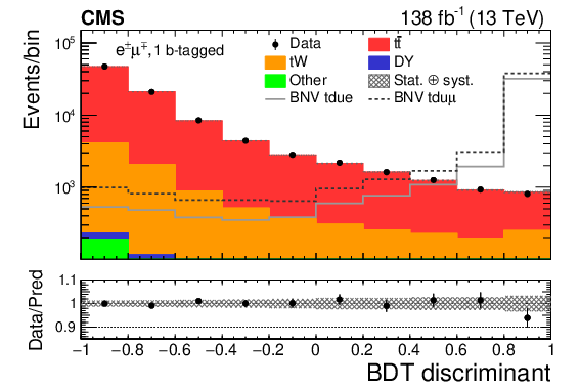
png pdf |
Figure 2-c:
The BDT output distributions for data (points) and backgrounds (histograms) for the $ \mathrm{e}^+\mathrm{e}^- $ (left), $ \mu^{+}\mu^{-} $ (right), and $ \mathrm{e}^\pm\mu^\mp $ (lower) channels, including the ratio of data to the predicted total background yield. The hatched bands indicate the total uncertainty (statistical and systematic added in quadrature) for the SM background predictions. The predicted yields of the backgrounds and the uncertainty bands are shown after the simultaneous fits for the signal-plus-background hypothesis. Examples of the predicted signal contribution for the BNV interactions via $ \mathrm{t}\mathrm{e}\mathrm{u}\mathrm{d} $ (solid gray line) and $ \mathrm{t}\mu\mathrm{u}\mathrm{d} $ (dashed black line) vertices are shown. |
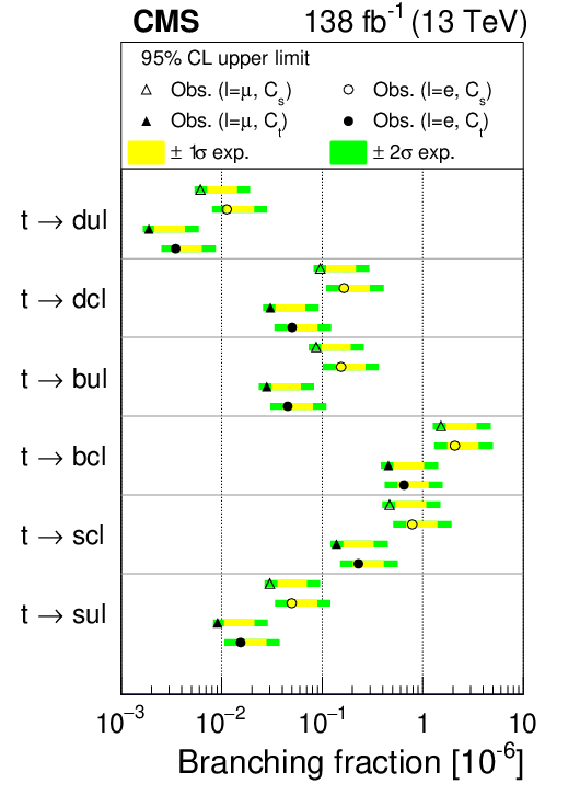
png pdf |
Figure 3:
The observed upper limits on the branching fractions of the top quark BNV decays are shown with circle and triangle shapes for electron and muon couplings, respectively. The observed limits corresponding to the $ C_t $ and $ C_s $ coefficients are shown with filled and open markers, respectively. The yellow light (green dark) bands indicate the range within plus or minus one (two) standard deviations bands around the expected limits. |
| Tables | |
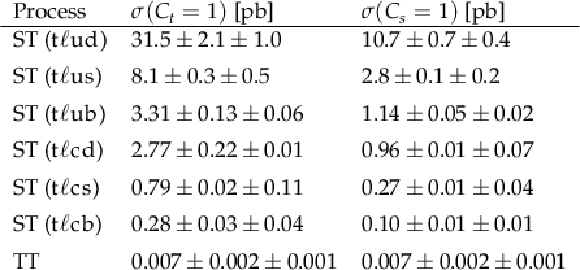
png pdf |
Table 1:
Theoretical inclusive cross sections, in units of pico barn (pb), for single top quark production (ST) and top quark-antiquark pair production with the decay (TT) via BNV interactions, assuming a top quark mass of 172.5 GeV, the top quark decay width 1.33 GeV, $ \Lambda= $ 1 TeV, and $ C_t = $ 1 or $ C_s= $ 1. The uncertainties arising from the choice of the renormalization and factorization scales and PDFs are given as ($ \sigma{\pm\text{Scale}}{\pm\text{PDF}} $). Here, the sum of the two cross sections is given where $\ell =$ e or $ \mu $. |
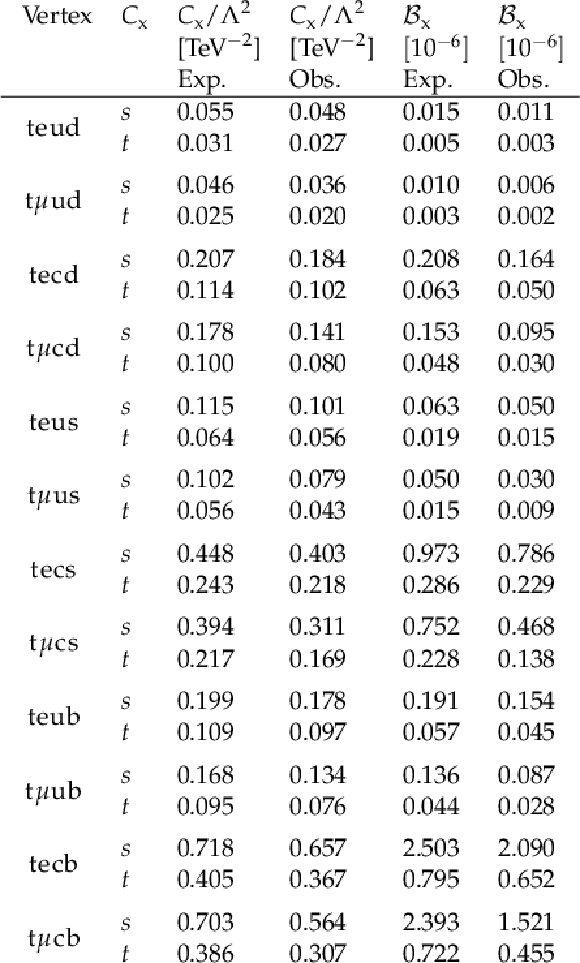
png pdf |
Table 2:
Expected and observed 95% CL upper limits on the BNV effective couplings and top quark BNV branching fractions. |
| Summary |
| In summary, a search for baryon number violation (BNV) in events with top quarks is performed using the LHC proton-proton collision data at a center-of-mass energy of 13 TeV. The analysis explores baryon number violating effects in single top quark production for the first time. Data were collected by the CMS experiment in 2016--2018 and correspond to an integrated luminosity of 138 fb$ ^{-1} $. Events with a lepton pair and exactly one b-tagged jet are selected. A boosted decision tree (BDT) is used to separate signal events from background events. A binned maximum likelihood fit to the BDT output distribution is performed to search for the BNV processes. Considering BNV vertices in the production of top quarks dramatically increases the sensitivity of this search. No significant excess of events over the background prediction is observed. Upper limits are placed on the strengths of the BNV couplings, which are multiple orders of magnitude more stringent than the previous limits [11]. |
| References | ||||
| 1 | G. 't Hooft | Symmetry breaking through Bell-Jackiw anomalies | PRL 37 (1976) 8 | |
| 2 | A. D. Sakharov | Violation of CP Invariance, C asymmetry, and baryon asymmetry of the universe | Pisma Zh. Eksp. Teor. Fiz. 5 (1967) 32 | |
| 3 | H. Georgi and S. L. Glashow | Unity of all elementary particle forces | PRL 32 (1974) 438 | |
| 4 | S. Weinberg | Supersymmetry at ordinary energies. 1. masses and conservation laws | PRD 26 (1982) 287 | |
| 5 | Super-Kamiokande Collaboration | Search for proton decay via $ p\to e^+\pi^0 $ and $ p\to \mu^+\pi^0 $ with an enlarged fiducial volume in Super-Kamiokande I-IV | PRD 102 (2020) 112011 | 2010.16098 |
| 6 | LHCb Collaboration | Searches for violation of lepton flavour and baryon number in tau lepton decays at LHCb | PLB 724 (2013) 36 | 1304.4518 |
| 7 | BESIII Collaboration | Search for baryon- and lepton-number violating decays $ D^0 \rightarrow \overline{p} e^+ $ and $ D^0 \rightarrow pe^- $ | PRD 105 (2022) 032006 | 2112.10972 |
| 8 | BaBar Collaboration | Searches for the baryon- and lepton-number violating decays $ B^0\rightarrow\Lambda_c^+\ell^- $, $ B^-\rightarrow\Lambda\ell^- $, and $ B^-\rightarrow\bar{\Lambda}\ell^- $ | PRD 83 (2011) 091101 | 1101.3830 |
| 9 | W.-S. Hou, M. Nagashima, and A. Soddu | Baryon number violation involving higher generations | PRD 72 (2005) 095001 | hep-ph/0509006 |
| 10 | M. E. McCracken et al. | Search for baryon-number and lepton-number violating decays of $\Lambda $ hyperons using the CLAS detector at Jefferson Laboratory | PRD 92 (2015) 072002 | 1507.03859 |
| 11 | CMS Collaboration | Search for baryon number violation in top-quark decays | PLB 731 (2014) 173 | 1310.1618 |
| 12 | S. Weinberg | Baryon and lepton nonconserving processes | PRL 43 (1979) 1566 | |
| 13 | Z. Dong et al. | Baryon number violation at the LHC: the top option | PRD 85 (2012) 016006 | 1107.3805 |
| 14 | CMS Collaboration | The CMS experiment at the CERN LHC | JINST 3 (2008) S08004 | |
| 15 | NNPDF Collaboration | Parton distributions from high-precision collider data | EPJC 77 (2017) 663 | 1706.00428 |
| 16 | T. Sjöstrand et al. | An introduction to PYTHIA 8.2 | Comput. Phys. Commun. 191 (2015) 159 | 1410.3012 |
| 17 | CMS Collaboration | Extraction and validation of a new set of CMS PYTHIA8 tunes from underlying-event measurements | EPJC 80 (2020) 4 | CMS-GEN-17-001 1903.12179 |
| 18 | GEANT4 Collaboration | GEANT 4 --- a simulation toolkit | NIM A 506 (2003) 250 | |
| 19 | P. Nason | A new method for combining NLO QCD with shower Monte Carlo algorithms | JHEP 11 (2004) 040 | 0409146 |
| 20 | S. Alioli, P. Nason, C. Oleari, and E. Re | A general framework for implementing NLO calculations in shower Monte Carlo programs: the POWHEG BOX | JHEP 06 (2010) 043 | 1002.2581 |
| 21 | S. Frixione, P. Nason, and C. Oleari | Matching NLO QCD computations with parton shower simulations: the POWHEG method | JHEP 11 (2007) 070 | 0709.2092 |
| 22 | J. Alwall et al. | The automated computation of tree-level and next-to-leading order differential cross sections, and their matching to parton shower simulations | JHEP 07 (2014) 079 | 1405.0301 |
| 23 | M. Czakon and A. Mitov | Top++: A program for the calculation of the top-pair cross-section at hadron colliders | Comput. Phys. Commun. 185 (2014) 2930 | 1112.5675 |
| 24 | M. Czakon et al. | Top-pair production at the LHC through NNLO QCD and NLOEW | JHEP 10 (2017) 186 | 1705.04105 |
| 25 | Y. Li and F. Petriello | Combining QCD and electroweak corrections to dilepton production in FEWZ | PRD 86 (2012) 094034 | 1208.5967 |
| 26 | N. Kidonakis | Two-loop soft anomalous dimensions for single top quark associated production with $ \mathrm{W^-} $ or $ \mathrm{H^-} $ | PRD 82 (2010) 054018 | 1005.4451 |
| 27 | J. M. Campbell, R. K. Ellis, and C. Williams | Vector boson pair production at the LHC | JHEP 07 (2011) 018 | 1105.0020 |
| 28 | F. Maltoni, D. Pagani, and I. Tsinikos | Associated production of a top-quark pair with vector bosons at NLO in QCD: impact on $ \mathrm{t}\overline{\mathrm{t}}\mathrm{H} $ searches at the LHC | JHEP 02 (2016) 113 | 1507.05640 |
| 29 | CMS Collaboration | Measurement of the $ \mathrm{t}\overline{\mathrm{t}} $ production cross section, the top quark mass, and the strong coupling constant using dilepton events in pp collisions at $ \sqrt{s} = $ 13 TeV | EPJC 79 (2019) 368 | CMS-TOP-17-001 1812.10505 |
| 30 | CMS Collaboration | The CMS trigger system | JINST 12 (2017) P01020 | CMS-TRG-12-001 1609.02366 |
| 31 | CMS Collaboration | Search for resonant and nonresonant new phenomena in high-mass dilepton final states at $ \sqrt{s} = $ 13 TeV | JHEP 07 (2021) 208 | CMS-EXO-19-019 2103.02708 |
| 32 | CMS Collaboration | Particle-flow reconstruction and global event description with the CMS detector | JINST 12 (2017) P10003 | CMS-PRF-14-001 1706.04965 |
| 33 | CMS Collaboration | Technical proposal for the Phase-II upgrade of the Compact Muon Solenoid | CMS Technical Proposal CERN-LHCC-2015-010, CMS-TDR-15-02, 2015 CDS |
|
| 34 | CMS Collaboration | Performance of electron reconstruction and selection with the CMS detector in proton-proton collisions at $ \sqrt{s} = $ 8 TeV | JINST 10 (2015) P06005 | CMS-EGM-13-001 1502.02701 |
| 35 | CMS Collaboration | Performance of the CMS muon detector and muon reconstruction with proton-proton collisions at $ \sqrt{s}= $ 13 TeV | JINST 13 (2018) P06015 | CMS-MUO-16-001 1804.04528 |
| 36 | M. Cacciari, G. P. Salam, and G. Soyez | The anti-$ k_{\mathrm{T}} $ jet clustering algorithm | JHEP 04 (2008) 063 | 0802.1189 |
| 37 | M. Cacciari, G. P. Salam, and G. Soyez | FastJet user manual | EPJC 72 (2012) 1896 | 1111.6097 |
| 38 | CMS Collaboration | Identification of heavy-flavour jets with the CMS detector in pp collisions at 13 TeV | JINST 13 (2018) P05011 | CMS-BTV-16-002 1712.07158 |
| 39 | CMS Collaboration | Performance of missing transverse momentum reconstruction in proton-proton collisions at $ \sqrt{s} = $ 13 TeV using the CMS detector | JINST 14 (2019) P07004 | CMS-JME-17-001 1903.06078 |
| 40 | CMS Collaboration | Cross section measurement of $ t $-channel single top quark production in pp collisions at $ \sqrt s = $ 13 TeV | PLB 772 (2017) 752 | CMS-TOP-16-003 1610.00678 |
| 41 | H. Voss, A. Höcker, J. Stelzer, and F. Tegenfeldt | TMVA, the toolkit for multivariate data analysis with ROOT | in XIth International Workshop on Advanced Computing and Analysis Techniques in Physics Research (ACAT) [PoS(ACAT)040], 2007 |
physics/0703039 |
| 42 | J. R. Quinlan | Simplifying decision trees | Int. J. Man-Mach. Stud. 27 (1987) 221 | |
| 43 | CMS Collaboration | Measurement of the top quark pair production cross section in proton-proton collisions at $ \sqrt{s} = $ 13 TeV | PRL 116 (2016) 052002 | CMS-TOP-15-003 1510.05302 |
| 44 | CMS Collaboration | Search for charged-lepton flavor violation in top quark production and decay in pp collisions at $ \sqrt{s} = $ 13 TeV | JHEP 06 (2022) 082 | CMS-TOP-19-006 2201.07859 |
| 45 | CMS Collaboration | Precision luminosity measurement in proton-proton collisions at $ \sqrt{s} = $ 13 TeV in 2015 and 2016 at CMS | EPJC 81 (2021) 800 | CMS-LUM-17-003 2104.01927 |
| 46 | CMS Collaboration | CMS luminosity measurement for the 2017 data-taking period at $ \sqrt{s} = $ 13 TeV | CMS Physics Analysis Summary, 2017 | CMS-PAS-LUM-17-004 |
| 47 | CMS Collaboration | CMS luminosity measurement for the 2018 data-taking period at $ \sqrt{s} = $ 13 TeV | CMS Physics Analysis Summary, 2018 | CMS-PAS-LUM-18-002 |
| 48 | CMS Collaboration | Measurement of the inelastic proton-proton cross section at $ \sqrt{s}= $ 13 TeV | JHEP 07 (2018) 161 | CMS-FSQ-15-005 1802.02613 |
| 49 | CMS Collaboration | Performance of CMS muon reconstruction in pp collision events at $ \sqrt{s}= $ 7 TeV | JINST 7 (2012) P10002 | CMS-MUO-10-004 1206.4071 |
| 50 | CMS Collaboration | Performance summary of AK4 jet b tagging with data from proton-proton collisions at 13 TeV with the CMS detector | CMS Detector Performance Note CMS-DP-2023-005, 2023 CDS |
|
| 51 | CMS Collaboration | Jet energy scale and resolution in the CMS experiment in pp collisions at 8 TeV | JINST 12 (2017) P02014 | CMS-JME-13-004 1607.03663 |
| 52 | CMS Collaboration | Measurements of $ \mathrm{t\overline{t}} $ differential cross sections in proton-proton collisions at $ \sqrt{s}= $ 13 TeV using events containing two leptons | JHEP 02 (2019) 149 | CMS-TOP-17-014 1811.06625 |
| 53 | CMS Collaboration | Measurement of the production cross section for single top quarks in association with W bosons in proton-proton collisions at $ \sqrt{s}= $ 13 TeV | JHEP 10 (2018) 117 | CMS-TOP-17-018 1805.07399 |
| 54 | A. L. Read | Presentation of search results: The $ CL_s $ technique | JPG 28 (2002) 2693 | |
| 55 | CMS Collaboration | HEPData record for this analysis | link | |

|
Compact Muon Solenoid LHC, CERN |

|

|

|

|

|

|